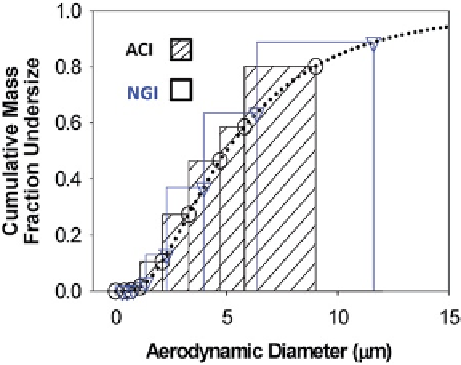Biomedical Engineering Reference
In-Depth Information
Fig. 4.10
Same data from
Fig.
4.9
presented in
cumulative mass-weighted
format (
From
[
78
]—
used by
permission
)
Mitchell and Dunbar also noted that the same data can be represented, perhaps
more conveniently, in cumulative mass-weighted format (Fig.
4.10
). It is this
approach that is most widely used to represent CI-based data because subcompo-
nents of the aerosol, such as extra-fine (EPF), fine (FPF), and coarse (CPF) particle
mass fractions, are readily obtainable from the ordinate scale (cumulative mass %
undersize) at the appropriate aerodynamic sizes, using the assumed form of the
APSD with infinitesimally fine resolution (dotted line). As this form of the APSD
considers only the impactor-sized mass (ISM), it is also possible to derive the mass
fractions that correspond to small (SPF) and large particles (LPF) in the context of
EDA-based data analysis. However, it is easier to obtain the ratio metric LPM/
SPM and ISM from the raw mass/stage data (Fig.
4.7
), and these measures are the
most useful for EDA analysis.
The cumulative mass-weighted APSD shown in Fig.
4.10
will not be helpful,
however, in cases in which an add-on device (spacer or VHC) is being used in
conjunction with an OIP, because the influence of the add-on cannot be assessed
unless the mass fractions are normalized to the total mass emitted from the
inhaler, including that captured by the non-sizing components, principally the
induction port.
In the case of spacers and valved holding chambers used with pMDIs, the add-on
eliminates the ballistic fraction of the aerosol emitted from the inhaler mouthpiece
that would normally be captured in the induction port [
80
]. The format illustrated by
Fig.
4.11
, which includes all the mass of API emitted from the actuator mouthpiece
of the pMDI entering an ACI as the example CI, is more appropriate for compari-
sons with and without add-on device. In this particular configuration, stage 0 has no
upper size limit, so that the APSD comparison is based on the total mass passing
beyond this stage compared with the total mass that deposits in the entire system
including the induction port.

Search WWH ::

Custom Search